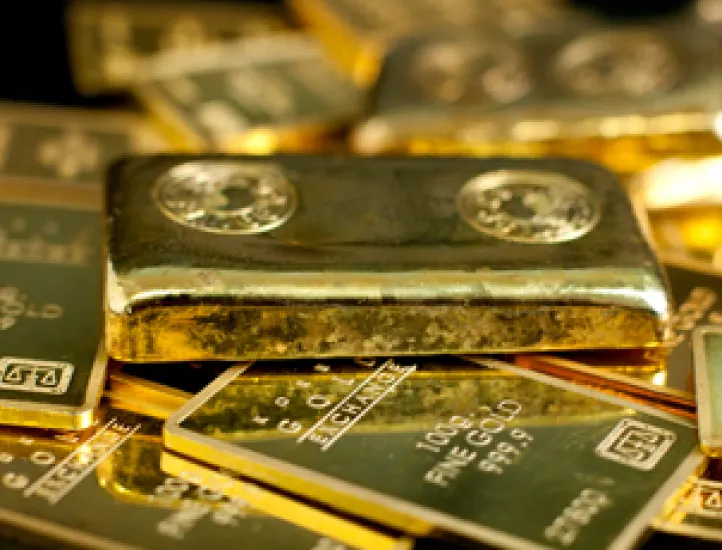The price of gold, which has enjoyed a steady, decade-long rally, went into overdrive this summer. Investors sought out the precious metal as a haven from geopolitical problems that piled up like cars in a freeway crash.
In the U.S. a political conflict over raising the federal government’s debt ceiling precipitated the loss of the nation’s triple-A credit rating from Standard & Poor’s. In Europe a sovereign debt crisis that had seemed under control just a year before exploded with violent force.
Meanwhile, as the global economy slowed at an alarming pace, there was a wave of revolution across the Middle East and riots in London. The lingering effects of natural disasters in Japan continued to drag on the world’s economy. Even China, which had provided a critical source of demand that helped ease the global recession of 2008 and 2009, was slowing down.
Against this bleak backdrop the price of gold soared to a record high of $1,923 an ounce on September 6. It’s declined a bit since then but remains at a level once considered unthinkable, closing on Wednesday, Sept. 7 at $1,838.40.
Will gold climb ever higher, or are investors experiencing a bubble that’s about to burst? That question is really just the starting point for a more complex discussion of the direction of the market and what that means for investors. If you’re convinced there’s a bubble, attempting to discern what kind of bubble it might be is the next challenge.
Institutional Investor asked several gold experts to assess the shape of things to come for the gold market. Here are edited highlights of their answers:
Jon Ruff, director of research for real asset strategies at AllianceBernstein
Institutional Investor: Has the price of gold formed a bubble?
John Ruff: We do think gold is in a bubble. It began about a decade ago. The price of gold was $256 an ounce in April 2001. It has gone up steadily since then. Although the annual gains actually haven’t been that large compared to other bubbles, it has lasted for a longer time. Most bubbles last somewhere between three and seven years. In the last few months, we have said the price of gold has entered into a new stage of the bubble.
We have done some work on bubbles of the past and how they have evolved: the gold bubble of the ’70s and early ’80s, Japan in the ’80s, tech stocks in the ’90s. What we tend to see is a blowout period to the upside during the later stages of the bubble. We think gold has entered that stage, where gold is crashing up.
If a gold bubble bursts, what happens next?
In the final stages of a bubble, there’s usually a move of 20 percent or 30 percent to the upside. Gold has made that move, but we actually think it may have more room to run. Many previous bubbles have ended because the market has been flooded with oversupply. But the supply of gold is finite, so the upside at the end might be greater.
Just how high can the price go from here?
It really depends upon whether the sovereign debt crisis in Europe gets much worse. You can make a case that it will. If the crisis in Europe doesn’t worsen, gold probably won’t go over $2,000 an ounce this year. But if the European situation does worsen, gold could reach $2,500 or perhaps even more.
And then what?
These things inevitably crash.
What do you think the downside will look like? Can you estimate how low the gold price might fall once the market turns?
You can.
Putting a value on gold can be difficult because it doesn’t generate cash. But one way to value it is to look at the production costs, which are now about $800 an ounce. In a crash the price might gravitate toward that point. It is a rough estimate, but in a crash investors might look toward that level.
How do you think investors can best position themselves in the gold market?
We actually have increased our recommended exposure to gold, to about 8 percent of the portfolio. It is possible to get exposure to any remaining upside and to limit downside risk. One way to do this is by purchasing gold volatility, an options play. The second way, which is a bit more risky, is to purchase shares of gold mining companies and to short the S&P 500 by a comparable amount. If the price of gold goes up, the gold miners will benefit. And the S&P 500 is likely to decline as investors become more risk-averse and move out of stocks. If the price of gold declines, the gold mining companies absolutely will go down in price; I can promise you that. But their shares won’t decline as much as gold itself because they didn’t share in the upside to the same extent.
Daniel Farley, chief investment officer, multi-asset-class solutions team, State Street Global Advisors.
Where do you think the price of gold is headed from here? Up or down?
We think the price is up.
When we look at the case for gold in the current environment, we need to think about it from a number of perspectives. The main uses for gold are jewelry, industry and investment. The jewelry market is somewhat flat, as is the industrial market. In our view this is largely an investment-driven rally. For some, gold has been used as a hedge against both the threat of inflation and the threat of deflation. Few people are loading up on gold right now as a hedge against near-term inflation, but that might be a concern five or ten years down the road. Some people are buying gold because it has been an effective store of value at times when other asset prices are falling. But the bigger driver of the rally probably is gold’s use as a currency hedge. When we look at the major currencies of the world, obviously there are concerns there. Central bank policy has been one of the biggest drivers. Central banks are moving their assets away from dollars and euros, and gold has been one of the biggest beneficiaries of that shift.
Will the rally continue?
I don’t think that the fiscal problems in the U.S. or the sovereign debt problems in Europe are going to be fixed immediately, so the move to gold still holds.
What is the potential upside from the current level?
We think that a reasonable view is that the price of gold can reach $2,000 to $2,500 an ounce in the next leg up. But it could move higher, depending upon how sovereign debt risks play out.
What, besides a resolution of the debt troubles in Europe, could lead to a drop in the value of gold?
The other risk is that if interest rates move up, then the case for a non-income-producing asset like gold might not be as strong. And if institutions significantly increase the margin requirements for trading gold, the demand for gold could decrease.
How has the perception of gold changed, especially among institutional investors?
Four or five years ago, many folks who touted the benefits of gold also espoused doomsday scenarios and advocated stocking up survival shelters with food, water and ammo. That isn’t the case anymore. Gold is now viewed by many institutional investors as one of the few ways to truly diversify a portfolio.
Joe Foster, portfolio manager of the $1.9 billion Van Eck International Investors Gold Fund
Do you believe that the rally in the gold market has formed a bubble?
No, not at all. I think we are in the middle of a bull market for gold. Over the near term we will consolidate gains at a very high level, and then it may move higher.
There are extraordinary things happening in the world, and they are bullish for gold. In the U.S. the Fed has said it will keep rates low for the next two years. Switzerland has moved to weaken the Swiss franc, and the euro is under pressure because of the European debt crisis. I don’t think the rally in gold will end until at least some of those conditions change.
What is the upside for the price of gold?
Over the near term it can easily go past $2,000. Over the longer term, the next three to five years, pick a number: $3,000 an ounce, $4,000 an ounce.
What is the best way for investors to gain exposure to gold?
Gold mining stocks are a screaming buy. They are very cheap, mostly because their expenses have been rising. Sometimes we think it makes sense to have more exposure to gold, and sometimes we think it makes more sense to own the stocks. Over the last year it clearly made sense to own gold. Now we think the stocks of the miners are a buy. In general, we advise a diversified approach to gold, through physical gold, stocks and other vehicles, such as ETFs.






